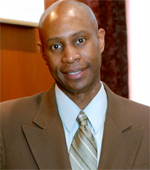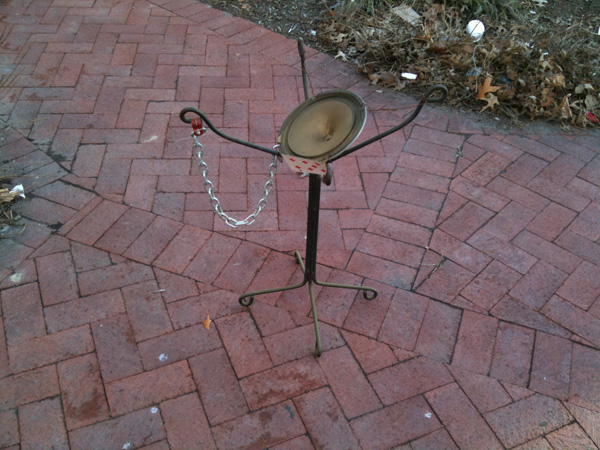Ward One Recap
There are few things the four candidates for the Ward One council seat agree on, but there’s one thing for sure: when asked which mayoral candidate they each endorse, all four candidates claimed to be undecided at this point.
At the Ward One Candidates Forum on Tuesday, all four candidates stated their cases for representing the ward after the upcoming election.

Jim Graham
Jim Graham (D) spent the entirety of his five minutes as most incumbents do, listing his accomplishments since his first election in 1998. Specifically he listed the following:
- that he secured funding for the beautification of Anna J. Cooper Circle in 2003;
- that he supported the Mary Church Terrell House project;
- that he got the 400 block of T Street named Walter Washington Way, after the LeDroit resident who was also DC’s first elected mayor;
- that he was “part of the neighborhood mobilization” in response to the robberies at the LeDroit Park Market several years back;
- that he was able to get the city to restore and renovate the Williston Apartments at 236 W Street into affordable housing apartments;
- that he has helped get city money for the Howard Theatre for its pending revitalization;
- that he has secured tax abatement legislation to get UNCF to move to Shaw, despite others’ objections to the use of tax abatement to lure development; and
- that he supported from the start the effort to turn the now-demolished Gage-Eckington School into something other than an abandoned building.
During the question and answer session, Mr. Graham also stated his support for school vouchers.
When asked about small-business set-asides for city contracts, Mr. Graham expressed his disappointment with the lack of enforcement. The problem, he stated, was not with the laws, but rather with their enforcement.

Marc Morgan
Marc Morgan (R), a resident of LeDroit Park, announced his love of the neighborhood and focused a good deal of attention on crime and small business development. He asked how many people feel safe walking around at night. He said he wants to facilitate the improvement of the District’s small businesses, which serve as the best sources of local employment.
Mr. Morgan also announced his environmental credentials and the importance of reducing carbon footprints. Throughout much of the question and answer session, Mr. Morgan touted the value of leveraging public-private partnerships to accomplish various worthy tasks, such as environmental protection and energy conservation. When asked if he had held elected office before, Mr. Morgan responded that he had owned a chain of restaurants in Ohio and Arizona and that he served as an environmental official in Ehrlich Administration in Maryland.

Jeff Smith
Jeff Smith (D) brought photos and graphs for his speech, which he started with the complaint that Ward One has become less green and over-developed. He didn’t hesitate to mention that one of Councilmember Graham’s top staff members had been indicted on corruption charges and that the Metro, under Mr. Graham’s continuing tenure on the WMATA board, has suffered a catastrophic crash and subsequent loss of public confidence.
Mr. Smith held up graphs illustrating that Ward One leads the city in robberies and thefts and a graph comparing proficiency ratings for DC public school students versus their counterparts in Maryland and Virginia.
Beyond graphs, Mr. Smith also held up photos of various blighted spots in Ward One that he claims languish despite the glitz in Columbia Heights and U Street. The crumbling Howard Theatre was one of them.
Mr. Smith expressed cautious support of Michelle Rhee and charter schools. When asked how he would pay for his plans, he trotted out the usual response of better management of existing funds.

Brian Weaver
The evening’s final candidate was Bryan Weaver (D), who is currently an ANC commissioner in Adams Morgan. Mr. Weaver started off announcing that his campaign’s theme was to bring accountability and oversight to the District government, a hot topic lately. He criticized DCPS for improperly assigning teachers and called nearby Cardozo High School the “school of least resistance,” by which he meant the dumping ground of problem children. Nonetheless, he praised Michelle Rhee for making “great progress” and he cautioned residents to be patient about school reform.
Regarding the city’s falling revenues, he said that we need to restructure the District’s tax code and rethink how the city does business. He brought up the recent park construction fracas as a prime example of waste.
Weaver was the only candidate of the evening to express the concern that Ward One is headed for a widening income gap and that we would become a ward of the well-off and the poor.
What issues matter to you the most?
U Street Booze Moratorium

At last night’s monthly meeting of ANC1B, Councilmember Jim Graham (D – Ward 1) suggested that the neighborhood could “benefit from discussion” of a liquor license moratorium on U Street. While the U Street corridor has experienced significant growth in the number of restaurants and bars over the past ten years, not everyone is happy with the revival. The bar scene, in the midst of a dense neighborhood is bound to create conflict especially as the corridor becomes a regional destination for bar-goers.
In fact one of the attractive features of U Street is that its bars have not become as raucous and overcrowded as those in Adams-Morgan. Part of the reason is that U Street attracts a different crowd (read: fewer college students) and includes more restaurants than actual bars. Furthermore, U Street stretches 0.8 miles (from Ninth to Seventeenth Streets) compared to Adams-Morgan’s 0.4 mi (along Eighteenth Street from U Street to Columbia Road). In reality the main bar strip of Adams-Morgan is packed into the 0.2 miles between Kalorama and Columbia Roads. That’s only one-fourth the length of the U Street corridor.

We know Adams-Morgan and U Street is no Adams-Morgan.
A moratorium on U Street would freeze the supply of available bar and restaurant space without alleviating the demand. In other words, a moratorium would eventually pack the existing venues. Customers will be stuck with the same selection of venues and would suffer higher prices and larger crowds at each venue.
Furthermore, we argue that this issue is already being addressed through two other avenues. First, the ANC is careful to review liquor licenses and doesn’t hesitate to strongarm restaurateurs and barkeeps into so-called “voluntary agreements” that stipulate a variety of restrictions. These restrictions aim to maintain the livability triumvirate of “peace, order, and quiet” so that neighbors can sleep without a cacophony of throbbing music, boisterous drunks, and gun shots. The process is not perfect, but neighbors are legally entitled to input and negotiation.
Second, the liquor issue is already being addressed by proxy of the zoning code. As we reported before, no more than 25% (soon to be raised to 50%) of street frontage along Fourteenth Street and U Street within the Uptown Arts Overlay zone can be devoted to food establishments. Since restaurants make much of their money by serving alcohol, the raising of the cap to 50%, an increase with significant, though not universal, community support, implies the acceptability of a commensurate increase in liquor licenses.
* * *
In other news, the ANC voted unanimously to approve the renewal of Class C restaurant liquor licenses for the following businesses:
- Shashemene Ethiopian Restaurant – 1909 Ninth Street NW
- Ambassador Restaurant – 1907 Ninth Street NW
- Zula Restaurant – 1933 Ninth Street NW
- Sala Thai – 1301 U Street NW
- Vinoteca – 1940 Eleventh Street NW
- Red Lounge – 2013 Fourteenth Street NW
- Gori Café – 1119 V Street NW
- La Carbonara – 1926 Ninth Street NW
- El Sol de America – 1930 Ninth Street NW
- Salina Restaurant – 1936 Ninth Street NW
- Chix – 2019 Eleventh Street NW
- Masa14 – 1825 Fourteenth Street NW (rooftop license modifications are a separate matter)
- Source – 1835 Fourteenth Street NW
- Prince Hall Freemason & Eastern Star Charitable Foundation – 1000 U Street NW
- Islander Caribbean Restaurant & Lounge – 1201 U Street NW
- The Saloon – 1205-1207 U Street NW
- Ulah Bistro – 1214 U Street NW
- Lincoln Theater – 1215 U Street NW
- Café Nema-Momo’s – 1334 U Street NW
- Dynasty Ethiopian Restaurant – 2210 Fourteenth Street NW
The ANC voted to withdraw its protest and enter into a voluntary agreement with Mesobe Restaurant (1853 Seventh Street NW). The commissioners voted to protest the renewal of Expo Restaurant and Nightclub (1928 Ninth Street NW) on account of noise and trash. They aim to draft a voluntary agreement with Expo. The commission decided to take no action on the renewal of licenses for Yegna (1920 Ninth Street NW) and Eatonville (2121 Fourteenth Street NW).
Finding Found Art

Ghetto Picasso's calling card.
…And CRASH!!! Sharesten, alone in The Christinsanity Chair, tilts over. The band plays on. Jo joins her. And the two balance The Christinsanity Chair. Friends fo’evah.
Wednesday morning we discovered that LeDroit Park had been “art bombed” with several found-art sculptures. The Brooklyn-based artist Ghetto Picasso adorned several sidewalks with his whimsical works. Each sculpture was tagged with a playing card with a few lines of prose and the artist’s web address. The artist describes himself thusly:
Theorizing the green movement as a last minute prayer before the Apocalypse, Ghetto Picasso symbolically interprets mankind’s edification efforts with the use of junk, salvage and reclaimed materials.
As detailed in his blog, Ghetto Picasso currently has an installation at Tryst in Adams Morgan.

Found at the LeDroit Park gate.

Found in the front garden at T and Sixth Streets NW

Attached to a fence at T and Wiltberger Streets NW
Lane Champlain
The District recently renovated and reopened Champlain Street to cars under the Marie Reed Center. The new street is one-way southbound for cars and includes a northbound contraflow bike lane. The reopened street will improve street connectivity between Adams Morgan and the U Street corridor. Currently, much of the car traffic is forced onto Ontario Road on the east and Eighteenth Street on the west.
The northbound contraflow bike lane will connect nicely to the westbound bike lane on V Street (mapped below). Though bicycles are entitled to ride on all District streets, LeDroit residents who prefer bike lanes will find a more relaxed route along V Street (from Vermont Avenue) westward to Florida Avenue, then northward on Champlain Street.
The roadway just south of the Marie Reed Center has been renamed Champlain Street to signify its continuation from the north. Its old namesake, Old Morgan School Place, has since been shortened from its former L-shape to its one remaining block between the Reed Center and the PEPCO substation.
We applaud DDOT and Councilmember Jim Graham (D-Ward 1), who spearheaded the reopening, for accommodating cyclists and connecting the street grids. Connected streets alleviate traffic jams as they provide more alternatives routes when the main streets become unexpectedly crowded.









Recent Comments